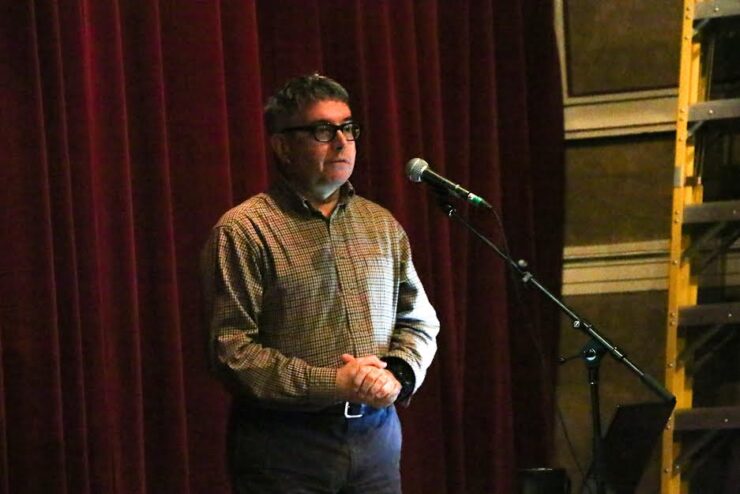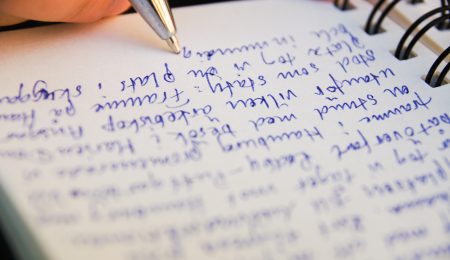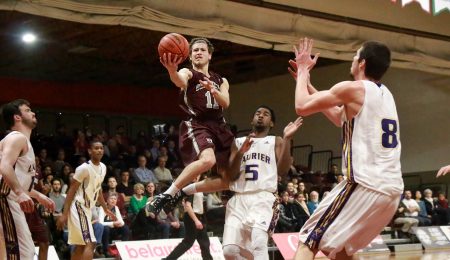Mark Dion talks art, science, and the environment in latest lecture at the U of O
Internationally recognized installation artist Marc Dion stopped by the University of Ottawa on Feb. 16 to give a lecture on public art, environmental decay, and the importance of collaborations between artists and scientists.
Dion, who was in town as a panelist for the Ephemeral Coast campaign’s “Image Ocean” workshop, took the room through a retrospective slideshow of his notable works, including his 1992 breakout installation “Nature Bureaucracies.”
Alternately whimsical and elegiac, Dion’s sculptures combine ocean specimens and esoteric commercial items to comment on the impact of industrial production on the natural world.
“A lot of my works deal with loss,” Dion told the room. “(Being) overwhelmed by catastrophe, sad at things disappearing.”
He cites his 2013 sculpture “Sea Life” as an example of this aesthetic. The work is a cart lined with illustrations of sea creatures and ocean-themed novels by authors such as Jules Verne, which, according to Dion, is a dual lament for the “loss of life in the sea (and) the loss of books and book culture.”
A constant theme of Dion’s work is the meaning inherent in seemingly insignificant objects, a principle taken from still-life painting.
While the collections of items arranged in his installations may look random, he explains that “every object has a layer of significance.” For instance, a closer look at the array of items featured in one of his harbourfront installations reveals hidden jokes, art history references, and commentary on the plight of traditional fishing communities.
While his work has been displayed at renowned institutions like the Metropolitan Museum of Art in New York, London’s Tate Gallery, and the Israel Museum of Art in Jerusalem, Dion is most passionate about his public installations. One of his notable public works is 2008’s “Mobile Gull Appreciation Unit,” an irreverent float designed to repair the tarnished public image of the seagull.
However, displaying art in public places always carries a risk. Dion notes that his famous “Ship-in-a-Bottle” sculpture in San Pedro, California has been vandalized multiple times, costing him tens of thousands of dollars to repair, and barriers had to be placed around another installation because “some idiot with a truck drove into it.”
Dion’s career has also featured harmonious collaborations with scientists, including biologist Lisa-ann Gershwin. Inspired by Gershwin’s research on jellyfish blooms as symptoms of a diseased ecosystem, Dion designed a multi-room installation featuring live jellyfish and all manner of jellyfish-themed art and kitsch, ending with a stark classroom setting. The 2016 exhibit was designed as deliberate a bait-and-switch to make viewers “fall in love with jellyfish” before exposing them as a dangerously-overpopulated invasive species.
“We’re creating a jellyfish-centric ocean,” Dion explains, describing the nightmarish tendency of jellyfish blooms to capsize fishing boats and clog the filters of nuclear submarines.
While Dion insists that scientists and artists have natural common interests, he admits it can be difficult for professionals in each field to appreciate each other’s work sometimes.
Dion recalls that a scientist he collaborated with once described his art as “incredibly simplistic,” stating that it looked like “something a child could do … but you’re getting all the attention, so something must be working!”
However, an artistic approach can go a long way in exposing scientific research to a wider audience, as his and Gershwin’s “The Trouble With Jellyfish” project demonstrates. It’s Dion’s deep-seated respect for science that allows him to embark on these symbiotic collaborations.
For someone who grew up in the former “capital of the industrial whaling industry” (New Bedford, Massachusetts) and worshipped oceanographer Jacques Cousteau as a child, using art to promote conservation seems like a surreal dream come true.
Dion’s work is featured in galleries all over the United States, and can be purchased online on websites such as artspace.com





